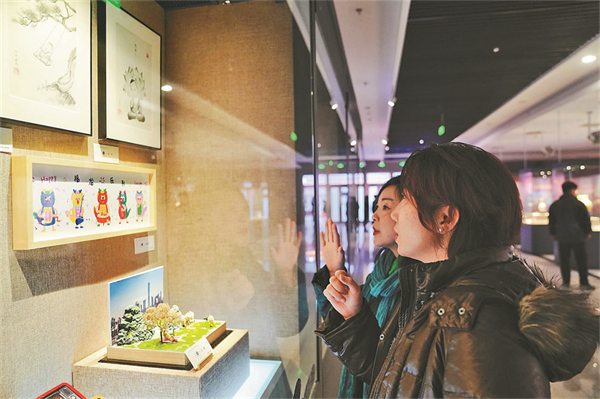Liu Dai'e practices the traditional craft of Tujia brocade weaving in her home village in Longshan county, Hunan province. [Photo/CHINA DAILY] Liu Dai'e completed dozens of orders for her handmade scarves and shawls bearing distinctive cultural elements of the Tujia ethnic group in time for Spring Festival, which falls on Saturday. Born and raised in a village in Hunan province, Liu has introduced over the past two years a new technique to the traditional craft of Tujia brocade weaving, which in 2006 was named as a national intangible cultural heritage. "Many of my customers like to wear these scarves and shawls for Spring Festival, or send them to their families and friends as gifts," said Liu, whose village is situated in Miao'ertan town, Longshan county. Tujia brocade woven by Liu Dai'e. [Photo/CHINA DAILY] In the Tujia language, the local brocade is known as xilankapu, which translates as "flower-patterned cover". Made by skilled weavers and involving more than 10 processes, including spinning, threading, knotting and rolling, Tujia brocade features over 200 classic designs. Liu, who is in her 60s, said: "Only one side of these traditional products is woven with patterns, while the other side is left rough. It took me six to seven years to master the technique of presenting distinctive Tujia elements on both sides to my complete satisfaction." Named a national inheritor of the craft in 2007, Liu said, "Handwork is involved throughout the process, and to produce designs that are more delicate than others, I use one shuttle line, instead of two." This is just one example of the innovative techniques Liu has used throughout her more than five decades of working with this traditional craft, which she started to practice with her grandmother. In 1986, Liu launched a Tujia brocade business with her sisters. "At that time, many people were struggling to make a living, and I wanted to use my skills to help them improve their lives," Liu said. She added that she also wanted to promote the brocade, which has helped preserve traditional culture, especially as the Tujia ethnic group does not have its own form of writing. After launching the business, Liu became acutely aware of the popularity of products featuring traditional designs made from materials such as silk and wool. She made a point of collecting ancient designs by trekking deep into the mountains that are home to Tujia villagers. "I tried to restore the old and discarded brocade items I bought," Liu said. As traditional thick Tujia brocade is often used as bedding by members of this group, Liu opts for silk, to achieve a lighter touch. She also uses the brocade to make handbags, and for paintings, which have proved popular with travelers. With the continuous development of the local culture and tourism industry, Miao'ertan is welcoming more visitors. After talking to a number of people, Liu sensed the way in which the local brocade industry needed to develop, and took it to a high-end customized market. Visitors tour an exhibition of works created under the Yuxun program at the Beijing Arts and Crafts Museum in October. [Photo/CHINA DAILY] On the 60th anniversary of the founding of Xiangxi Tujia and Miao autonomous prefecture in 2017, she led seven apprentices and spent nine months weaving a huge Tujia brocade featuring classic designs such as flowers, birds, heavenly beings, and auspicious symbols. The item is on display at the Xiangxi Intangible Cultural Heritage Museum. Liu has also woven portraits of her customers into brocade items, which have sold well. "We need to create high-quality, high-end products to preserve the good things in life. Only in this way can we enhance confidence in ethnic culture and achieve social and economic benefits," she said.


Traditional Culture Given a Modern Twist
Editor:谭婕倪
Source:enghunan.gov
Updated:2024-02-14 09:14:21
Source:enghunan.gov
Updated:2024-02-14 09:14:21
Special
Contact
Welcome to English Channel! Any suggestion, welcome.Tel:0731-82965627
lisl@rednet.cn
zhouqian@rednet.cn











